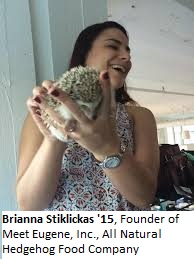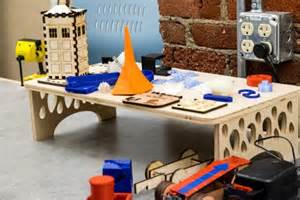Indulge Your Curiosity and Find Your Own FabLab
While the pace of life doesn’t slow for many of us during the summer, these warmer months can provide opportunities to explore different terrains. Some are spending the summer trying out new roles with companies, others exploring the world, helping family, or taking classes. However you’re spending your time right now, let yourself meander into some uncharted territory and see where your curiosity leads you. Look for spaces and experiences that bring to life talents and dreams that may lie dormant during the hectic academic year.
Things That Make You Go Hmmmm
Earlier this week, I spent some time in the Butler Summer Accelerator space, humming with activity of startups ranging from haunted houses, to hedgehog food/lifestyle products, to a drone pilot training academy. I had the chance to connect with Ryan Lupberger ’18 (Community Manager of eTower) and Professor Stephen Brand (Professor of Entrepreneurship at Olin College and Summer Venture Program Adviser at Babson) to chat about eTower’s upcoming year. (eTower is Babson’s Undergraduate Student Entrepreneurship Club and Residential Living Community). Of the many ideas and expertise tossed around, one question stuck with me – what does entrepreneurial thought and action look like in a residential living community? What is it about the space that fosters creativity? How do the residents spend their time, interact/provoke each other, think differently, and take risks?
When Curiosity Gets the Best of You
Pondering these questions and yearning to learn more, I landed upon some TED Talks by Sir Ken Robinson, British Author and International Education Adviser with specific expertise on the creative challenges facing business and education in the new global economies. (By the way, with over 32 million views, this is TED’s most watched presentation!) As I learned more about him, I was drawn to a Times article citing his work as raising “some of the most important issues facing business in the 21st century (giving) every CEO and HR Director (reason to) thump the table demanding action.”
“I define creativity as the process of having original ideas that have value” — Sir Ken Robinson
Robinson speaks passionately (and humorously!) about our innate creativity, found in its purest state in children. He shares deep concerns about our educational systems, and the emphasis on control and conformity. Rather than enforcing standardized curricula aimed at achieving prescribed outcomes for all students, he argues for individualized approaches focused on inspiring curiosity through creative teaching and surroundings. He views successful education as organic, providing each student with the right climate to grow, rather than a series of mechanical processes aimed at producing similar outputs. Creativity and innovation are the drivers in our global economy. An educational system that loses so many students along the way (Robinson cites 60% high school drop out rates in some areas of the country, and 80% among Native Americans) by stifling these drivers is a system in crisis.
When The Answers are In Front (or Inside) of You
 Sometimes all we need to do to find answers is to open our eyes to what is in front of us. My very curious ten year old has fallen in love with science, dance, arts, sports, reading (fantasy, mystery and anything having to do with WW2), story writing, social studies, and recently horses and dogs. Where does math fall in her love affair with school and life? It doesn’t – she and math have not been on friendly terms this past year. So, her parents were quite unpopular when they decided upon an academic/recreational camp for 5 weeks this summer. Three days into camp, her eyes were on fire when she came home and described the camp’s FabLab and her work on the 3D laser printer, Maker-bot and laser cutter. In fact, she is designing a 3 dimensional frame that involves measurements, angles, precise calculations, and a variety of math and engineering concepts. In just three days, she has come alive in an engaging, kinesthetic, inspiring climate where her own creativity drives her learning. The FabLab is her happy space where math comes alive, because it touches her creative potential in a way that untaps and engages her mathematical talents. Is this the type of educational climate that Sir Robinson speaks to — and perhaps, in part, is it one answer to what a educational/living environment looks like that inspires creativity, passion, and entrepreneurship?
Sometimes all we need to do to find answers is to open our eyes to what is in front of us. My very curious ten year old has fallen in love with science, dance, arts, sports, reading (fantasy, mystery and anything having to do with WW2), story writing, social studies, and recently horses and dogs. Where does math fall in her love affair with school and life? It doesn’t – she and math have not been on friendly terms this past year. So, her parents were quite unpopular when they decided upon an academic/recreational camp for 5 weeks this summer. Three days into camp, her eyes were on fire when she came home and described the camp’s FabLab and her work on the 3D laser printer, Maker-bot and laser cutter. In fact, she is designing a 3 dimensional frame that involves measurements, angles, precise calculations, and a variety of math and engineering concepts. In just three days, she has come alive in an engaging, kinesthetic, inspiring climate where her own creativity drives her learning. The FabLab is her happy space where math comes alive, because it touches her creative potential in a way that untaps and engages her mathematical talents. Is this the type of educational climate that Sir Robinson speaks to — and perhaps, in part, is it one answer to what a educational/living environment looks like that inspires creativity, passion, and entrepreneurship?
What Does Your FabLab Look Like?
So, whether you’re listening to iTunes on the train home from your internship, backpacking through Europe, working in your family business, or taking summer classes on a campus that has a different rhythm at this time of year, pay more attention to the things that make you go hmmmm. Indulge your curiosity and see where it leads you. Open your eyes to the answers that lie before you. Find spaces that let dormant ideas and talents find their way to the sun. If you can gain a sense of your own FabLab – the space where your creative sensibilities are unleashed – you will begin to understand the internal compass that will guide your life and career decisions at Babson and beyond. What does yourFabLab look like? I can’t wait to hear!
